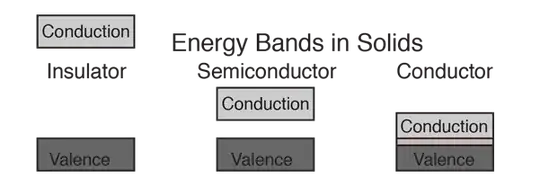Lets say you have a closed circuit connected to a battery made of copper wire. Lets say that at one point of the copper wire there is plastic. The electrons can't flow through the insulator and back into the wire. What force is allowing the repulsion of these electrons from entering the insulator? If there is no force acting on the electrons why aren't the excess electrons flowing through the insulator and into the copper wire?
2 Answers
What is happening here is that you have introduced a potential barrier between the two tips of the wire. The electrons cannot* jump across this barrier. There is no force as you describe.
- there maybe a point however where if you made the voltage sufficiently high, the electrons can travel across the insulator. This is called the breakdown voltage of the insulator and is the minimum voltage that causes the insulator to become conductive.
- 31,821
What force is allowing the repulsion of these electrons from entering the insulator?
At the level of electrons one is in the quantum mechanical frame. In this frame there are no forces on the electrons in the sense of the classical frame. There are possible solutions of the quantum mechanical equations which define the probable paths of the electrons.
In general electrons are bound quantum mechanically to atoms because of the Coulomb potential entering the equations, and are stable there. In lattices, as the conductors and resistances of a macroscopic electric circuit, there are possibilities on how they are bound, because there are spill over electric fields that change the atomic solutions. This means that in conductors there are solutions where the electrons are bound to the whole lattice, and thus can move around it. In insulators no such solutions exist. This is modeled with the band theory of solids:
useful way to visualize the difference between conductors, insulators and semiconductors is to plot the available energies for electrons in the materials. Instead of having discrete energies as in the case of free atoms, the available energy states form bands
It may help to look at this semiclassical microscopic view of current: . In insulators the electrons are bound well in the valence band, a lot of energy is needed to be able to get to the conduction band.
- 236,935
